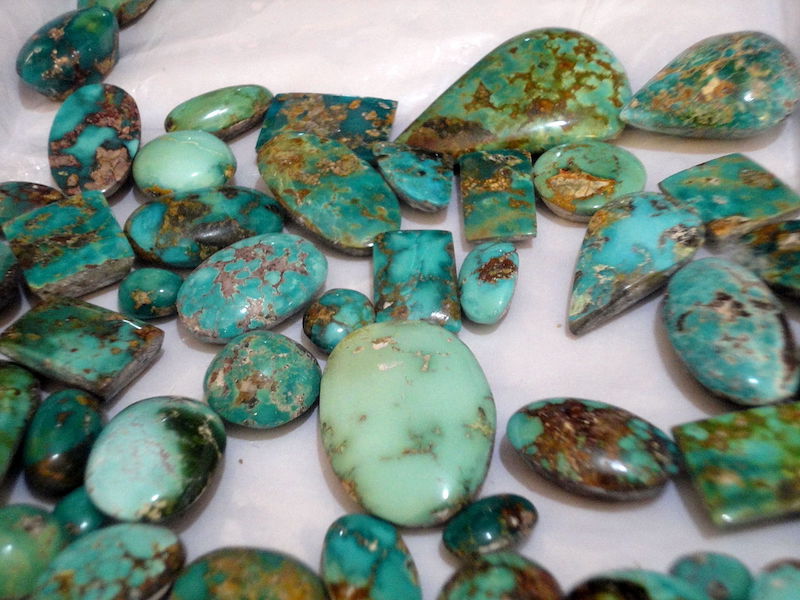
Turquoise, a captivating gemstone and color, sits at the intersection of blue and green hues, making it a unique blend of both. Its vibrant appearance often leans more towards blue, but subtle hints of green are always present, creating a mesmerizing balance that defines its distinctive character. This article delves into the fascinating world of turquoise, exploring its properties, the interplay of its blue and green tones, its enduring appeal, and its diverse uses throughout history and today.
From its geological origins to its cultural significance, we’ll uncover the secrets behind this beloved gemstone. Get ready to discover why turquoise continues to captivate hearts and inspire creativity.
Turquoise Gemstone Properties
Turquoise is a hydrated copper aluminum phosphate mineral with the chemical formula CuAl6(PO4)4(OH)8·4H2O. It typically forms in veins within limestone, shale, or sandstone deposits, often associated with other minerals like chalcopyrite and malachite.
The vibrant blue-green color of turquoise is attributed to the presence of copper ions within its crystal structure. The intensity and shade of the color can vary depending on factors such as the amount of copper present, the type of surrounding minerals, and the geological conditions during formation.
Turquoise is a relatively soft gemstone, ranking 5 to 6 on the Mohs hardness scale. This means it’s susceptible to scratching and abrasion, making proper care essential to preserve its beauty.
Blue and Green Hues in Turquoise
The captivating allure of turquoise lies in its unique blend of blue and green hues. While some specimens may appear predominantly blue, a subtle hint of green is always present, creating a harmonious balance that defines its character.
The Influence of Copper
The intensity and shade of both blue and green in turquoise are influenced by the amount of copper present within its crystal structure. Higher copper content often results in a more vibrant blue hue, while lower copper levels can lead to a greener appearance.
Variations in Shade
Turquoise exhibits a wide range of color variations, from sky-blue to deep teal, with hints of green ranging from olive to emerald. These variations are influenced by factors such as the presence of other trace elements, the geological conditions during formation, and the specific location where the turquoise was mined.
The Perception of Color
The perception of blue and green in turquoise can also be subjective, influenced by individual preferences, lighting conditions, and the surrounding colors. Some individuals may perceive a particular piece of turquoise as predominantly blue, while others may see it as more green.
The Unique Appeal of Turquoise
Turquoise has captivated hearts for centuries, prized for its beauty, rarity, and cultural significance. Its vibrant color evokes feelings of serenity, tranquility, and connection to nature.
Historical Significance
Turquoise has been revered throughout history by various cultures, often associated with protection, good luck, and spiritual power. Ancient civilizations in the Americas, Asia, and Europe used turquoise in jewelry, ornaments, and ceremonial objects.
Cultural Symbolism
In many cultures, turquoise is believed to possess healing properties and ward off evil spirits. It’s also associated with wisdom, communication, and friendship. These beliefs have contributed to its enduring popularity as a gemstone.
Modern Appeal
Today, turquoise continues to be a popular choice for jewelry, home decor, and fashion accessories. Its unique blend of blue and green hues adds a touch of vibrancy and sophistication to any piece.
Uses of Turquoise
Turquoise has been used in a wide range of applications throughout history and today.
Jewelry Making
Turquoise is a highly sought-after gemstone for jewelry making, prized for its vibrant color and durability. It’s often set in silver, gold, or platinum, creating stunning necklaces, earrings, bracelets, and rings.
Decorative Arts
Turquoise has been used in decorative arts for centuries, adorning vases, bowls, sculptures, and other objects. Its unique color adds a touch of elegance and sophistication to any piece.
Industrial Applications
In some cases, turquoise is also used in industrial applications, such as the production of pigments and ceramics.
Turquoise Jewelry
Turquoise jewelry has been cherished for centuries, symbolizing protection, good luck, and beauty.
Styles and Designs
Turquoise jewelry comes in a wide variety of styles and designs, from classic to contemporary. Popular styles include:
- Native American Jewelry: Often featuring intricate silverwork and turquoise stones set in traditional patterns.
- Southwest Style: Characterized by bold colors, geometric shapes, and the use of turquoise alongside other gemstones like coral and lapis lazuli.
- Modern Designs: Incorporating turquoise into minimalist or contemporary settings, showcasing its vibrant color in a sleek and modern way.
Care and Maintenance
To preserve the beauty of your turquoise jewelry, it’s important to follow proper care instructions:
- Avoid exposing turquoise to harsh chemicals, such as chlorine or bleach.
- Clean your turquoise jewelry with a soft cloth and mild soap solution.
- Store your turquoise jewelry in a dry place, away from direct sunlight and heat.
Conclusion
Turquoise, with its captivating blend of blue and green hues, continues to enchant us with its beauty and cultural significance. From its geological origins to its diverse uses, this gemstone has left an indelible mark on history and remains a beloved treasure today. Whether adorning jewelry, adding a touch of vibrancy to home decor, or simply serving as a reminder of nature’s artistry, turquoise holds a special place in our hearts and continues to inspire awe and admiration.
